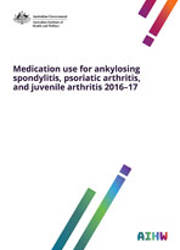Summary
Arthritis and other musculoskeletal conditions are common chronic conditions affecting the bones, muscles and connective tissues. There are various treatment and management options for musculoskeletal conditions, including pharmacological and non-pharmacological interventions.
Medications are used to treat and manage musculoskeletal conditions, by reducing pain and inflammation, improving mobility and slowing disease progression. This report focuses on medications commonly used for the specific musculoskeletal conditions of ankylosing spondylitis, psoriatic arthritis, and juvenile arthritis. These conditions were selected because there are several medications listed on the Pharmaceutical Benefits Scheme (PBS) that should only be prescribed to treat these conditions.
The report further assesses the feasibility of using PBS data to estimate the prevalence of juvenile arthritis.
Medication use for ankylosing spondylitis
In 2016–17, 81,500 prescriptions for medications specific to the treatment of ankylosing spondylitis were dispensed. The majority of these prescriptions (44%) were for adalimumab.
In 2016–17, $124.6 million was spent on these medications. This included $122.5 million of benefits paid by the Australian Government, and $2.2 million of patient contributions (out-of-pocket costs).
The number of patients dispensed these medications differed by age and sex, being most commonly dispensed to males (65% compared with 35% females) and people aged 40–49.
Medication use for psoriatic arthritis
In 2016–17, 141,000 prescriptions for medications specific to the treatment of psoriatic arthritis were dispensed. The majority of these prescriptions (45%) were for leflunomide.
In 2016–17, $120.3 million was spent on these medications. This included $117.4 million of benefits paid by the Australian Government, and $2.9 million of patient contributions (out-of-pocket costs).
The number of patients dispensed these medications differed by age and sex, being most commonly dispensed to females (62% compared with 38% males) and people aged 50–69.
Using PBS data to estimate prevalence of juvenile arthritis might be feasible
The number of children living with juvenile arthritis is difficult to estimate reliably using large population surveys because it is a rare condition found in a subset of the population (children aged under 16).
Analysis of de-identified unit record PBS data produced an estimate of up to 5,400 children living with juvenile arthritis in 2016–17, who were prescribed medication from the PBS.
Further analysis using linked data is recommended
Additional analysis using linked data would be valuable to validate methods used for this report and to investigate more complex research questions, including outcomes. Further analysis is recommended to provide a more comprehensive picture of medication use for musculoskeletal conditions.



